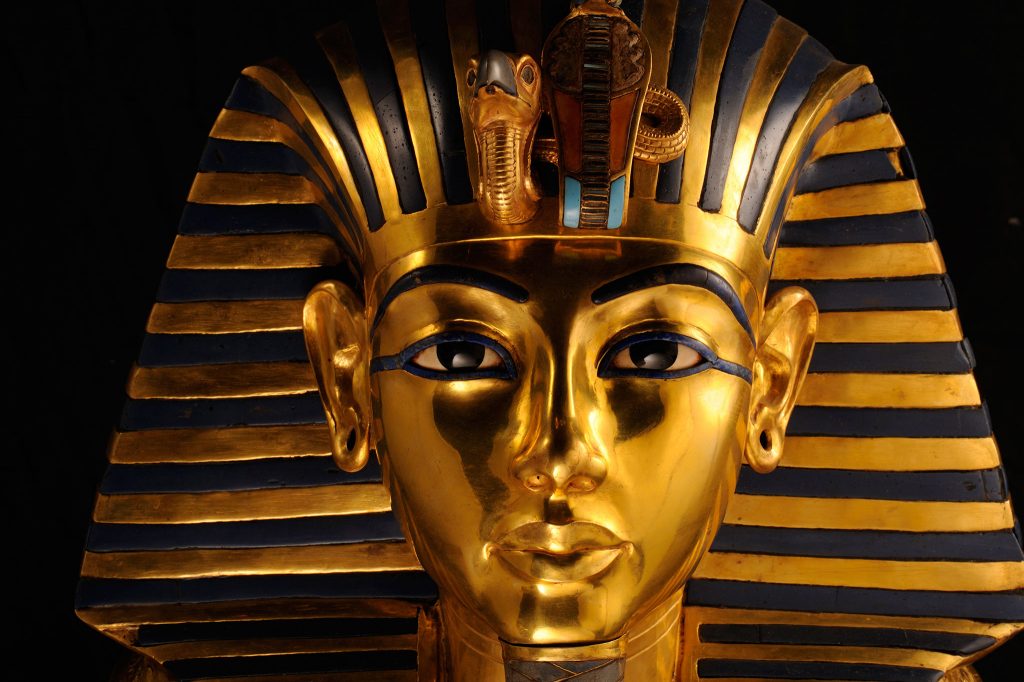Thanks to modern technology, the examination and research into mummified bodies and artifacts from ancient Egypt have answered many questions for scientists and historians alike. What was the culture of these ancient people? Who were their leaders? And what was the process and purpose of mummification? In the twentieth century, the tomb of King Tutankhamen was discovered, and that discovery has answered many of these questions. Thanks to the discoveries of the Ancient Egyptian’s burials of their kings, particularly that of King Tutankhamen, we have learned more and more about the Ancient Egyptian’s history and traditions when it comes to laying the dead to rest.

Scientists and archaeologists say that King Tutankhamen became king at the very young age of nine. However, he may have been no more than a puppet ruler, and the true power behind the throne was said to belong to a man who may have been related to Tut named Ay. Young Tut was a physically frail youth. Through the examination of his body, scientists have found malformations in his feet, and they suspect that the young man had walked with a cane.1 Though he was depicted as fighting in battles and slaying enemies in drawings on the walls of his tomb, there is no actual evidence that this young man participated in any actual battles. However, scholars believe that these depictions merely represent an extension of Tut’s power. It was believed that he married his half-sister, Anthesenpaaton, who was also very young. Though the two had not produced any known heirs, the bodies of two babies were found buried in Tut’s tomb. Archaeologists believe these babies may have been the children of young Tut and his queen.2 He reigned during a period of time known as the New Kingdom. At the young age of eighteen, Tut’s short life and reign over Ancient Egypt had come to an end. The exact cause of Tut’s death remains a mystery; however, scientists believe it may be connected with an infection spread by a broken leg.3
In 1922, the tomb of King Tut was discovered. This finding helped give archaeologists an understanding of the wealth of Egyptian civilization, especially for those living in the upper class. The value of the gold and treasure found in King Tut’s tomb, as was the case for treasures found in other areas of ancient Egypt, surpass that of many others discovered from ancient times. It also has given scientists and researchers much insight into the history, tradition, and science behind the process and purpose of mummification.4
Scholars have discovered that mummifying bodies was tied to the ancient Egyptians’ belief about the afterlife. Egyptians believed that the body was not just a corpse after death, but a resting place for the soul. Osiris, the god of the resurrection and a very respected god to the Egyptians, would judge the soul of the dead.5 Because the Egyptians believed the soul would move on, King Tut’s final resting place was filled with tools and items that the King might need in the afterlife. It contained artifacts such as clothing, musical instruments, jewelry, lamps, chairs, and baskets with food and wine. In addition to the tomb itself, much has been discovered from bodies that were laid to rest so many years ago, including the body of King Tut. The success of the preservation can be accredited to the detail that the ancient Egyptians provided during the process of mummification. Through many years of research and observation, scientists and archaeologists have found that this important practice evolved over time, but it has followed the same basic instructions and procedures.6 After his death, all of Tut’s organs were removed from the body, except the heart, and placed into containers called Canopic Jars. Afterwards, Tut’s body was then covered in a mixture called natron, which consisted of salts that helped inhibit bacterial activity and dehydrate the body. After a little over a month, the mixture of salts was removed from Tut’s body and his cavities were filled with cloth containing resin to give the corpse its shape back. Only after this was the body wrapped with linen, giving it the classic “mummy” appearance. Tut was then placed in a solid gold coffin, and the coffin was then placed in his tomb.7
Traditionally, it was only emperors, kings, and members of the upper class who were mummified, but as time progressed it became a tradition for many members of this ancient society.8
However, because Tut was a king, his resting place was filled with ancient artifacts and treasures in addition to his mummified corpse. Although his reign, and his life, were cut very short, the ancient Egyptians left more than a final resting place for the boy King’s soul when they laid him to rest: they left us, the people of the 21st century, with answers.
- Phillip A. Mackowiak, Diagnosing Giants:Solving the Medical Mysteries of Thirteen Patients Who Changed the World (Oxford: Oxford University Press, 2013), 3. ↵
- Salem Press Biographical Encyclopedia, January 2015, s.v. “Tutankhamen,” by Donald C. Simmons. ↵
- Salem Press Biographical Encyclopedia, January 2015, s.v. “Tutankhamen,” by Donald C. Simmons. ↵
- G. Elliot Smith, Tutankhamen and the Discovery of His Tomb (Routledge: Hoboken, 2013), 1. ↵
- E. A. Wallis Budge, Egyptian Religion : Egyptian Ideas of the Future Life, Routledge Revival (London: Rutledge, 2013), 41. ↵
- Salem Press Encyclopedia of Science, January 2015, s.v. “Mummification,” by James L. Robinson ↵
- Salem Press Biographical Encyclopedia, January 2015, s.v. “Tutankhamen,” by Donald C. Simmons. ↵
- George Hart, Ancient Egypt (New York: DK Publication, 2008), 1. ↵



87 comments
Tyanne Pearcy
I’ve never really been interested in ancient civilization but this story of King Tut was surprisingly engaging. It is crazy that he was king at the young age of 9 years old and how extensive his reign lasted. In addition the fact that he dies at age 18 from an unknown cause was also very shocking. I love how King Tuts discovery help archeologist figure how ancient Egypt functioned as a society during these times.
Roman Olivera
can you imagine become the King at the age of nine? The power given to a nine year old and the decision making ability that has not developed at that age. There was really no life experience with a child of that age to determine that they can lead a kingdom. This is an interesting article that talks about the mummification of King Tut and the reason they did it they way they did. I had no idea they removed all the organs with the exception of the heart. It’s very intriguing to see that they depicted him as a King that fought many battles yet his remains show that his feet were malformed making him basically crippled.
Lamont Traylor
King Tut is so well known that he has many golf places named after him. I really only like his story because of the science behind how he was buried and how he was made into a mummy. The embalming of ancient times is probably my favorite information about Egypt. I like the mystery behind things like that and the pyramids.
Noah Bolhuis
It is amazing that one of the weakest and youngest pharaohs led to more knowledge than any other pharaoh or discovery throughout ancient Egypt. The discovery of his tomb truly showed they wealth of Egypt in the ancient world, the true deity view of the pharaoh, and what they thought of the afterlife. However, it is quite obvious that they did not know the risks of incest and what that causes, as his malformations were probably due to this.
Sofia Andrade
In third grade I did a history project of King Tut, through this history project I learned of him and his role in history. It was interesting to read this article that focused on the mummification of King Tut and the findings based on the discovery of his mummy. I did not know that in the mummification process all of the organs were removed except for the heart, and those organs that were removed were preserved in Canopic Jars. I also learned that the mummification process takes weeks to complete.
Sebastian Carnero
It is interesting how Egyptians believed that the body was a resting place for the soul and how things such as jewelry or wine and food as a whole can be useful in the afterlife. I’m impressed by how much they respect their leaders and their beliefs. The amount of work needed to make a tomb, the coffin made out of solid gold, and the process of mummification is tremendous. I didn’t matter that Tut’s reign was only 9 years.
Madison Downing
I honestly loved your article because reading about ancient civilizations is just so fascinating to me personally. I can’t believe that King Tutankhamun became a king only at the age of 9 and his reign only lasted for another 9 years. He died in his prime but it seemed (from what you wrote about the cane) that he was probably in pain all this life. I honestly hope he didn’t already have 2 children because he was so young but I guess it was traditional to have them at a early age back then. You wrote a really interesting article and it was a lot of fun reading it!
Brianna Ford
I never read an article liked this, and its so interesting what archeologist and scientist can find with old dna. It amazes me that they can find out so much with just gold and the treasure as evidence. what also amazes me is that the mummy is still put together, I figured it would have not been put together at all. It is also sad to hear that King Tutankhamen married his half sister and died at such at young age. It is like he was thrown into something unwillingly and just never had a child hood.
Indhira Mata
When both scientists and archaeologists are working together to answer worldwide questions, the discoveries can be endless. The Egypt people believed in the afterlife which explains why they would bury their kings in tombs wrapped. Along sided them would be their families and items they would be known to like once brought to live again. How they were able to find all these answers with one finding is amazing. Our technology is surely improving and will possibly get us further answers.
Eric Ortega Rodriguez
Wow, it is fascinating to read on what archeologist and scientist can accomplish when working together. It is interesting to read up on the story of King Tutankhamen. I think it’s outstanding how scientist and archaeologist can look at evidence and draw conclusions from that. Such as when they discovered he had malformations in his feet which made walking difficult for him and depictions only represented
the extension of King Tutankhamen’s power not his physical strength. Overall, a very interesting article with great images!